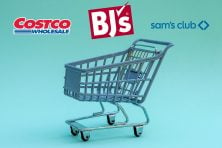Store Brand vs. Name Brand: What’s Really Worth the Extra Money?

What’s in a name? A lot, actually. Especially when it comes to store brand vs. name brand grocery items.
We often default to certain brands when shopping simply because of the name on the package — and the reputation that comes along with it — thanks to clever advertising.
We buy Bounty paper towels because they’re “the quicker picker-upper” and Frosted Flakes because “they’re gr-r-reat.”
But on the shelves next to those items you can often find a comparable store-brand version that costs less — sometimes significantly less.
So which is better — the name brand or the off brand? Let’s dive in to find out.
Save More Money Outside Shopping Store Brand vs. Name Brand
Shopping store brand vs. name brand products can often save you money. As you decide which products you want to buy the store brand of, you may want to know other ways you can save. Check out some of our favorite ways to save money below.
| Offer | Why We Like It | What You Need to Do | Start Saving |
|---|---|---|---|
| The Penny Hoarder Auto Insurance Tool | Save ~$500 per year | Provide some basic information | |
| AmOne | Save on interest payments with a personal loan | Answer a 10 quick qualifying questions | |
| Balance Transfer Credit Cards* | Cancel Your Interest Payments Until 2026 | Apply for a 0% Interest Credit Card | |
| Upside | Save $40/month on Gas | Download this free app |
Are Store Brands Really as Good as Name Brands?
No, not always! Many times, store brands will use the same formula as name brands, but they’re able to sell for a cheaper price because of the quality of the ingredients or materials used to manufacture that formula. Other times, a store brand will be a knock-off from an entirely different company or manufacturer, striving to replicate the name brand – and getting pretty close.
Still other times, it’s the exact same product with a different label slapped on. In these instances, the store brand really is just as good as the name brand.
Even if the store brand isn’t always technically “as good,” you may find that it’s close enough for your liking. A lot of the judgement is subjective. There’s trial and error involved, and in some cases you might land right back on the premium paper towels after trying the generic version because you find that Bounty really does pick up more, and quicker.
Why Store Brands Cost Less (and How They Keep Prices Low)
Many times, store brands are keeping costs lower by using lower-grade ingredients or materials to make the product. In some instances, they’ll work with the people already manufacturing the product to put a store-brand label on it so they don’t incur all the costs of setting up their own manufacturing facilities.
This helps the store provide price segmentation. The idea behind price segmentation is that some people will be brand loyal and pay the higher price no matter what. Generally speaking, you can make a larger profit off these customers — even if you’re paying slightly more for higher-quality ingredients and incurring the costs of a larger marketing budget.
But what about those people who will only buy if the product is more affordable? That’s where the store-brand comes in. By providing similar products at different price points, you capture a larger share of potential buyers. When you’re doing this in large volume, this strategy can help bring in more profit even if the store-brand product provides the store with less profit per unit.
Other Ways to Save on Groceries and Household Items
There are other ways to stretch your grocery budget beyond buying store-brand products. An app called Upside can help you earn real cash back when you go to the grocery store, as well as when you dine out or fill up your gas tank. Upside can help you earn an additional $290 each year with cash back offers at thousands of restaurants and grocery stores, making your everyday expenses even more manageable.
And if you ever buy groceries or household items online, you could use Capital One Shopping to figure out if you’re overpaying. Just add it to your browser for free, and before you check out, it’ll check other websites to see if your item is available for cheaper.
Store Brand Products That Almost Always Win
To get a pulse on which store brand products are preferred over others, we turned to Penny Hoarders. One said she’s always been partial to JIF smooth peanut butter, but was sold when she tried her store’s own organic smooth peanut butter which was less than $2. She described it as “good, if not better.”
Her opinion tracks. Peanut butter is one food in America that has a “Standard of Identity” (SOI). That means before it goes on shelves, it has to meet certain FDA metrics. Peanut butter in particular has specific metrics with high percentages that make most brands relatively consistent. The peanut butter must be made of 90% peanuts with no more than 55% fat content to make it onto American shelves.
If a food item has an SOI, you’re likely to have a harder time telling the name brand from the store brand. Here are some other food items that have SOIs, though it’s hardly an exhaustive list:
- Milk and cheese
- Many bread products
- Milk chocolate
- Canned and frozen vegetables
- Noodles and macaroni
- Ice cream and sherbet
It goes beyond food items, though. For example, Penny Hoarder Jobelle Collie said she’s partial to Dove bar soap, Olay moisturizer and Palmolive green dishwashing liquid – but buys generic trash bags and office supplies. That makes sense to this writer – a number two pencil is a number two pencil, even if it doesn’t say “BIC” on the side.
One of the best store-brand products around is Kirkland batteries. Back in 2016, Duracell copped to manufacturing this Costco brand, and many consumer tests since show that Kirkland performs just as well as the name brand. Whether or not they’re manufactured using exactly the same materials is not officially confirmed. But since the performance is just as good, that technicality might not matter terribly.
Brand-Name Items That Are Usually Worth the Splurge
Jobelle wasn’t alone. We found that among our community members, the most persistent item they wanted to buy brand name was their beauty products. While sometimes there’s a rogue store brand product that really does work just as well as the brand name and has the same ingredients, overall we think this is a wise move.
While garbage bags and notebooks might not be too hazardous to your health, anything you put on your skin can get absorbed into your bloodstream. It feels OK to want those higher-quality materials in these instances. (This is also why you should be careful about buying beauty products from online-only retailers, where the standards aren’t always as stringent as they are off a shelf in a physical store.)
Other preferences for brand name are likely to be individual and subjective. If you have a picky eater, they might be able to tell the difference between cookies made with Great Value flour versus Gold Medal. Store-brand cola might be just fine for some people, but others will cringe at anything other than Coke.
Regional preferences exist, too. Ketchup is a great example. It’s technically a product with an FDA SOI, but try giving anyone in Pittsburgh the store-brand (or worse – Hunt’s), and they’ll send you running for the hills. In the Golden Triangle, it’s Heinz or bust, and the regional palette can tell the difference.
Tips for Deciding on Store Brand vs. Brand Name
There are some products — like Kirkland batteries and staples like milk or salt — that really don’t justify the spend on brand-name.
But for many other items on your shopping list, you’ll have to make priorities within your own budget according to your own tastes. If you really want the name-brand shampoo, maybe you can get by with knock-off plastic baggies. If you’re prioritizing your ketchup spend, maybe you can purchase store-brand tomato sauce and add some herbs and spices while you’ve got it on simmer because you’re not as picky when it comes to spaghetti night.
You’ll also want to consider the actual price differences combined with coupons. At Publix, the difference between store-brand and JIF was a mere $0.07 when we ran a comparison in St. Petersburg, Florida. But at Walmart? The price difference was $0.92.
One of those store brands is saving you a whole lot more money than the other. If you have a coupon that gives you $0.50 off JIF when all is said and done, that would end up being cheaper than the Publix store brand – but not Walmart’s.
Store Brand vs. Brand Name: Smart Shopping Isn’t About Labels
At the end of the day, shopping store brand vs. brand name products across any particular category doesn’t make you a better person or a smarter shopper. A lot of it comes down to preferences. Because while some products like Kirkland batteries may be identical to the name brand, a lot of times demoting yourself from name brand to off brand really does mean sacrificing a little bit of quality.
It’s all about doing the trial and error to figure out where that sacrifice is worth it to you and your family according to your budget.
Pittsburgh-based writer Brynne Conroy is the founder of the Femme Frugality blog and the author of “The Feminist Financial Handbook.” She is a regular contributor to The Penny Hoarder. Nicole Dow and JoEllen Schilke also contributed.












